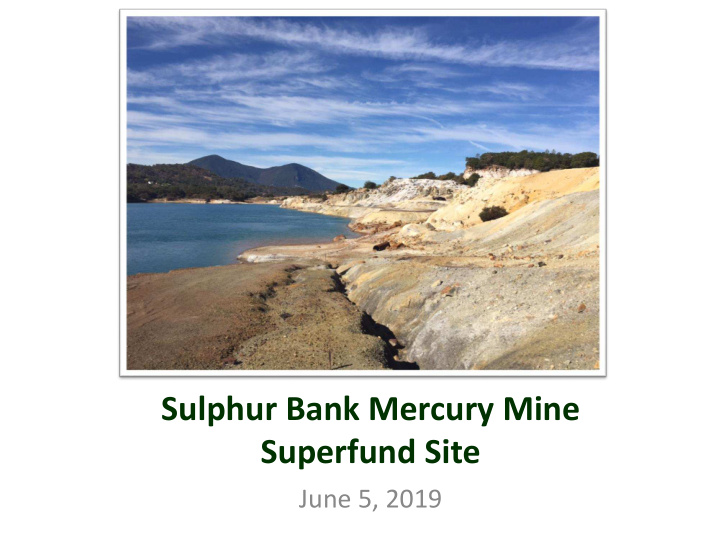



Sulphur Bank Mercury Mine Superfund Site June 5, 2019
Presentation Overview • Introduction of EPA Staff • Site Overview • Superfund Process • EPA Actions to-date at SBMM • Site Impacts on Clear Lake Water Quality • Next steps • Discussion
Key EPA Team Members Carter Jessop, Project Manager Kelly Manheimer, Section Chief Alejandro Díaz, Community Involvement Coordinator Margot Perez-Sullivan, EPA Office of Public Affairs John Lucero, E2 Consulting Engineers
Site Overview Sulphur Bank Mercury Mine Principle Site Contaminants: • Operated on and off 1865 to • Mercury and arsenic in soils 1957 • Produced 7 million pounds of mercury • Mercury in sediment and fish • Added to the Superfund list in 1990 tissue • Fish consumption advisory for Clear Lake Located on Oaks Arm of Clear Lake, south of Clearlake Oaks, adjacent to the Elem Indian Colony
Major Mine Site Features Source Areas – Waste Rock Piles – Ores Piles – Tailings Pile – Disturbed and Native Rock – Northwest Pit – Mining Facilities/Buildings Herman Impoundment (HI) Waste Rock Dam (WRD) Off-Site Residential Soils – Elem Indian Colony – BIA 120 – Sulphur Bank Mine Road neighborhood 5
Site Overview Terrestrial Mine Site and Residential Soils Operable Unit 1 Lake Sediments and North Wetlands Operable Unit 2
Superfund Process • Comprehensive Environmental Response and Compensation Act (CERCLA) - “Superfund” • Established in 1980 • EPA performs cleanups performed under two authorities: – Removal Process – discrete action, usually < $2 million – Remedial Process – more complex, higher cost 6/6/2019 U.S. Environmental Protection Agency 7
The Remedial Process 1 2 3 4 5 6 7 8 9 Preliminary Placement on Remedial Proposed Plan Record of Remedial Remedial Long-Term Feasibility Assessment / the National Investigation Study (PP) Decision Design Action Operations & Site Inspection Priorities List (RI) (FS) (ROD) (RD) (RA) Maintenance (NPL) (O&M) OU-1 OU-2 Community involvement and planning for a site’s future r euse are integral parts of the entire process. Early actions to protect human health
Actions to Reduce Exposure Human Health – Site Controls (Fencing) – Removal of soils, replacement of homes and infrastructure on EIC (1997,1998,2006) – Geothermal well closures (2000-2001) – Removal of soils from Sulphur Bank Mine Road residential area (2008) – Pomo Road cleanup (2010) Clear Lake – Stabilization of Waste Rock Dam (1992) – Stormwater Diversion/Pipeline (1999-2000) – Sediment test caps in Clear Lake (2012-2016)
Water Quality SBMM Impacts on Clear Lake Water Quality 4 pathways SBMM contaminants to enter Clear Lake 1. Direct placement during mining operations 2. Erosion of mine waste, usually stormwater or direct sloughing of unstable areas 3. Overflow of Herman Impoundment 4. Mine-impacted groundwater discharges into the lake, primarily HI water moving through the WRD
Conceptual Site Model
Revised Site Understanding Changes in Herman Impoundment water quality • Stormwater divisions and drought led to improved water quality in Herman Impoundment – pH from around 3 to nearly 5 • Capping the exposed mine waste at the site would further: • Reduce acid rock drainage • Reduce hydraulic head pushing water through WRD • Reduce contaminant loading into Clear Lake • Once waste is capped, HI water chemistry modeled to move toward background groundwater quality
OU-1 Focused Feasibility Study The Focused FS brings together all of the information gathered about OU-1 of the SBMM Site and compares remedial alternatives • Draft-Final Focus Feasibility Study complete • Incorporating input from CA Department of Toxic Substances Control, Central Valley Waterboard, and Elem Tribe • 3 new alternatives proposed by Elem Tribe - screening of these alternatives now complete • Finalization of FFS will allow next steps toward Proposed Plan for OU-1 cleanup 13
Water Quality Part 2 • Mercury binds to soil and sediment • Clear Lake water contains low/safe levels of mercury • Methylation of mercury makes it available for biological uptake • Primary pathway for exposure – methylmercury in fish • Poor correlation between sediment concentrations and fish tissue concentrations - additional study needed
Fish Consumption Advisory CA OEHHA Fish Advisory, Updated August 2018
Remedial Investigation OU-2 Additional Study Needed • Data collection since 1980 • EPA sponsored work by UC Davis, USGS, others • No firm answers on effect of remedial action alternatives • Proposed USGS partnership • Coordination with Blue Ribbon Committee sampling work 6/6/2019 U.S. Environmental Protection Agency 16
Other Ongoing Work Site-wide Human Health Risk Assessment • Sampling in coordination with Elem cultural practices • Looking at exposure pathways and rates specific to tribes • Considering traditional foods Waste Rock Dam Flux Monitoring • Better quantify total Hg moving through the WRD Background Soils Investigation • What would levels of contaminants be were it not for SBMM mine? Stormwater BMP Repairs • Scheduled for fall 2019
Non-Time Critical Removal Action Northwest Waste Rock Pile • Adjacent to and partially in North Wetlands, Elem lands • Placement into NW Pit • Consistent with final remedy • Reduces risk to public and environment • Engineering Evaluation/Cost Analysis pending – late 2019 • Public meeting before finalization 18 6/6/2019 U.S. Environmental Protection Agency
Tribal Consultation Government-to-government consultation • Meaningful communication and coordination between EPA and tribal official • Invite open dialog with all interested Lake County Tribes Coordination with Elem Tribe • Working with the Elem Environmental Department since 1990 • Superfund Cooperative Agreement to facilitate Elem involvement • Feedback throughout FFS process • Regular communication and coordination on field work, site plans and document development • Input on outreach and education • Tribal monitors
Discussion
Recommend
More recommend